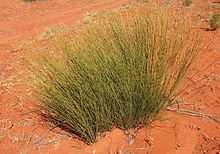Exocarpos sparteus
| Exocarpos sparteus | |
|---|---|
 | |
| Scientific classification | |
| Kingdom: | Plantae |
| (unranked): | Angiosperms |
| (unranked): | Eudicots |
| (unranked): | Core eudicots |
| Order: | Santalales |
| Family: | Santalaceae |
| Genus: | Exocarpos |
| Species: | E. sparteus |
| Binomial name | |
| Exocarpos sparteus R.Br. | |
Exocarpos sparteus is an Australian endemic plant species, commonly known as the Broom Ballart or native cherry. The species is found in all states of mainland Australia.
Description
A shrub, four metres tall, erect, with drooping branchlets, almost leafless. The species bears flowering branchlets, which may have small, greenish-yellow, and stalkless leaves. The flowers are just 1 mm across and of a similar colour, occasionally white. The fruit of this species is egg-shaped, pink or red, and between 4 and 5 mm long.
The habit of this plant is upright, becoming slightly curved, combining with the many regular branches to form a rounded aspect. The smooth and spherical appearance of the species is given by the droop of the branchlets, the similar colour and size of the leaves and flowers, and upcurving of the outward branches.
Naming
The specific name is derived from the Latin word esparto, referring to a kind of Spanish grass that was used for its fibre. It was first described by Robert Brown, in 1810, having collected the plants on his visit to King George Sound in 1802. One of the species' common names, Native Cherry, is given to another cogenor with an edible fruit, Exocarpos cupressiformis; both of these species are known as sorts of Ballart.
Ecology
The fruit of E. sparteus is eaten by Australian Ringnecks (Barnardius zonarius) and, presumably, other birds. It is also thought to be the Exocarpos species eaten by people in Australia, especially prior to colonisation. The species is a hemi-parasite, gaining nutrients from other plant's roots, a process undertaken by many in the Santalaceae family.
References
- Robert Powell (1990). Leaf and Branch. Department of Conservation and Land Management.
- Australian Encyclopaedia Volume 2, p 175, Angus and Robertson Limited, 1926
- "Exocarpos sparteus R.Br.". FloraBase. Department of Environment and Conservation, Government of Western Australia.